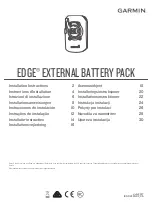
PREPARING TO CHARGE
1.
Determine voltage of battery by referring to car owner's manual.
2.
If necessary, remove battery from vehicle to charge, or to clean terminals, always remove grounded
terminal from battery first. Make sure all accessories in the vehicle are off, so as not to cause an arc.
3.
Clean battery terminals. Be careful to keep corrosion from coming in contact with eyes or skin.
4.
Add distilled water in each cell until battery acid reaches manufacturer’s specified level. This helps purge excessive gas
from cells. Do not overfill. For a battery without cell caps, carefully follow manufacturer's recharging instructions.
5.
Study all battery manufacturers' precautions such as removing or not removing cell caps while charging and recommend-
ed charging rates.
6.
Area around battery should be well ventilated while battery is being charged. Gas can be forcefully blown away by using
a piece of cardboard or other non-metallic material such as a fan.
7.
Make sure the initial charging rate does not exceed manufacturer’s recommendation.
CHARGER LOCATION
1.
Locate charger as far away from battery as cables permit.
2.
NEVER
place charger directly above battery being charged; gases from battery will corrode and damage charger.
3.
NEVER
allow battery acid to drip on charger when reading specific gravity or filling battery cells with battery acid.
4.
NEVER
operate charger in a restricted or non-ventilated area.
5.
Marine batteries must be removed and charged on shore.
6.
Do not set a battery on top of charger.
DC CONNECTION PRECAUTIONS
1.
Connect and disconnect DC output clamps only after unplugging AC cord from outlet.
2.
Never allow clamps to touch each other.
3.
Attach clamps to battery posts and check for secure connection. This will hold clamps securely on terminals and helps to
reduce risk of sparking.
FOLLOW THESE STEPS WHEN BATTERY IS INSTALLED IN VEHICLE. A SPARK NEAR BATTERY
MAY CAUSE BATTERY EXPLOSION. TO REDUCE RISK OF A SPARK NEAR BATTERY:
1.
Position AC and DC cords/cables to reduce risk of damage by hood, door, or other moving engine parts.
2.
Stay clear of fan blades, belts, pulleys, and other parts that can cause injury.
3.
Check polarity of battery posts. POSITIVE (POS, P, +) battery post usually has larger diameter than NEGATIVE (NEG,
N,-) post.
4.
Determine which battery post is grounded (connected) to the chassis. If negative post is grounded to chassis (as in
most vehicles), see (5). If positive post is grounded to the chassis, see (6).
5.
For negative-grounded vehicle, connect POSITIVE (RED) clamp from battery charger to POSITIVE (POS,P, +) post
of battery. Connect NEGATIVE (BLACK) clamp to vehicle chassis or engine block away from battery. Do not connect
clamp to carburetor, fuel lines, or sheet-metal body parts. Connect to heavy gauge metal part of the frame or engine
block.
6.
For positive-grounded vehicle, connect NEGATIVE (BLACK) clip from battery charger to NEGATIVE (NEG, N, -) post
of battery. Connect POSITIVE (RED) clamp to vehicle chassis or engine block away from battery. Do not connect
clamp to carburetor, fuel lines, or sheet-metal body parts. Connect to a heavy gauge metal part of the frame or engine
block.
7.
When disconnecting charger, disconnect AC cord first. Then remove clamps from vehicle chassis from
battery terminal.
8.
Refer to operating instructions for length of charge information.
9.
Do not charge the battery while the engine is operating.
3






























